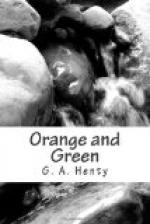The rumour spread through both armies that the king was killed; but the wound was a slight one, and, having had it hastily bound up, the king rode quietly through the camps, in order to show the men that the hurt was not serious. In the evening, he called a council of war. The Duke of Schomberg was strongly opposed to an attack upon the enemy, while posted in so strong a position, and urged that, by making a turning movement and marching straight upon Dublin, the enemy would be obliged to fall back, and fight under less advantageous circumstances. But the king, relying upon his superior numbers and the discipline of his veteran troops, determined to attack at once, knowing that it was all important to bring the matter to a decision, as early as possible.
Schomberg then urged the necessity of occupying the pass of Slane, upon the Boyne, considerably to the west of the Irish line, as he would thus cut off their retreat, and, in the event of victory, render their defeat a decided one; but the king saw that he should require his whole force to dislodge the Irish from their position, and that it was useless to occupy the pass of Slane with a small detachment, as these would be overwhelmed by the retiring Irish.
It was twelve o’clock at night, before the council terminated, and then the king mounted his horse and rode through the camp. He examined into the state and preparation of each regiment, saw that the soldiers were abundantly supplied with food and refreshment for the morning, and that sufficient ammunition for the day’s work had been served out. He directed the men to wear green branches in their caps, and gave “Westminster” as the word for the day.
The order of the battle finally determined upon was that the right wing of the army, under General Douglas and Count Schomberg, son of the duke, should pass the river at Slane and endeavour to turn the Irish left, between Slane and Duleek. The left wing were to penetrate between the Irish right and Drogheda; the centre to force the passage of the river, at the ford of Old Bridge.
A council was also held in James’s camp, and here also there was difference of opinion. Some of the generals wished to hold the pass of Slane in force, but James decided against this. As the morning approached, the king’s newborn courage began to die out. He ordered some movements to the rear, and sent forward more of his baggage. He would probably have declined the combat altogether, had it not been too late. Finally, just as day was breaking over the council, he determined that the army should retreat during the battle, and not commit themselves in a decisive engagement. The French formed the left, and were to lead the retreat, while the Irish held the right and centre.
It is almost certain that, if James had kept to his resolution to fight, imprudent as it appeared to be, and had brought the French battalion into action, instead of leading them out of the field, the result of the battle of the Boyne would have been a very different one.




